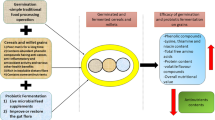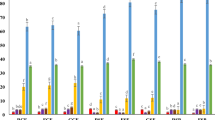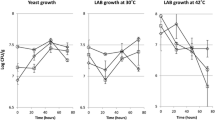Abstract
Cereals and legumes are rich in minerals, but the bioavailability of these minerals is usually low due to the presence of anti-nutritional factors, such as phytate, trypsin inhibitors, and tannin. Reductions in the influence of these factors is necessary to derive the full nutritive value of cereals and grains. Penicillium camemberti was grown on millets (kodo millet and proso millet) and legumes (moth beans and cow peas). Fermented grains were analyzed for the influence of anti-nutritional factors. Fermentation reduced the phytic acid content in proso millets. The tannin contents were reduced in both moth beans and cow peas while there were reductions of 38.3% and 74.3% in alkaloid contents in fermented moth beans and cowpeas. The trypsin inhibitor contents also decreased in all legumes and millets after solid state fermentation.
Similar content being viewed by others
References
Soetan KO, Oyewole OE. The need for adequate processing to reduce the antinutritional factors in plants used as human foods and animal feeds: A review. Afr. J. Food Sci. 3: 223–232 (2009)
Badau MH, Nkama I, AI Jideani. Phytic acid content and hydrochloric acid extractability of minerals in pearl millet as affected by germination time and cultivar. Food Chem. 92: 425–435 (2005)
Shurtleff W, Akiko A. History of Miso, Soybean Jiang (China), Jang (Korea) and Tauco (Indonesia) (200 BC-2009). Soyinfo Center, Lafayette, CA, USA. p. 627 (2009)
Shurtleff W, Aoyagi A. The Book of Tempeh. Soyinfo Center, Lafayette, CA, USA p. 8 (2001)
Yokotsuka T. Recent advances in shoyu research (Soya sauce, Koji mold, Aspergillus oryzae, Aspergillus sojae, Japan). pp 171–196. In: The Quality of foods and beverages: Chemistry and technology. Charalambous G, Inglett G (eds). Academic Press, New York, NY, USA (1981)
Bizet C, Desobry S, Fanni J, Hardy J. Composition and physical properties of the Penicillium camemberti mycelium. Lait 77: 461–466 (1997)
Vaintraub IA, Lapteva NA. Colorimetric determination of phytate in impurified extracts of seeds and the products of their processing. Anal. Biochem. 175: 227–230 (1988)
Saxena V, Mishra G, Vishwakarma K, Saxena A. A comparative study on quantitative estimation of tannins in Terminalia Chebula, Terminalia Belerica, Terminalia Arjuna and Saraca Indica using a spectrophotometer. Asian J. Pharm. Clin. Res. 6: 148 (2013)
Hamerstand GE, Black LT, Glover JD. Trypsin inhibitors in soy products: Modification of the standard analysis procedure. Cereal Chem. 58: 42–45 (1981)
Harborne JB. Methods of plant analysis in: Phytochemical Methods. Chapman and Hall, London, UK. pp. 11–21 (1973)
Zamora AF, Fields ML. Microbiological and toxicolgical evalution of fermented cowpeas (Vigna sinensis) and chickpeas (Cicer arietinum). J. Food Sci. 44: 928–929 (1979)
Sandberg AS, Andlid T. Phytogenic and microbial phytases in human nutrition. Int. J. Food Sci. Tech. 37: 823–833 (2002)
Melaku U, West CE, Habtamu F. Content of zinc, iron, calcium and their absorption inhibitors in food commonly consumed in Ethiopia. J. Food Compos. Anal. 18: 803–817 (2005)
Gargari BP, Mahboob S, Razavieh SV. Content of phytic acid and its mole ratio to zinc in flour and breads consumed in Tabriz, Iran. Food Chem. 100: 1115–1119 (2007)
Ejigui J, Savoie L, Marin J, Desrosiers T. Beneficial changes and drawbacks of a traditional fermentation process on chemical composition and antinutritional factors of yellow maize (Zea mays). J. Biol. Sci. 5: 590–596 (2005)
Cui L, Li DJ, Liu CQ. Effect of fermentation on the nutritive value of maize. Int. J. Food Sci. Tech. 47: 755–760 (2012)
Chung K-T, Wong TY, Wei C-I, Huang Y-W, Lin Y. Tannins and Human Health: A Review. Crit. Rev. Food Sci. 38: 421–464 (1998)
Agte VV, Gokhale MK, Chiplonkar SA. Effect of natural fermentation on in vitro zinc bioavailability in cereal-legume mixture. Int. J. Food Sci. Tech. 31: 29–32 (1997)
Osman MA. Changes in sorghum enzyme inhibitors, phytic acid, tannins and in vitro protein digestibility occurring during Khamir (local bread) fermentation. Food Chem. 88: 129–134 (2004)
Abdel-Rahman IE. Microbiological and biochemical change during fermentation of sorghum. M.Sc. Thesis, Faculty of Agriculture. University of Khartoum, Khartoum, Sudan (2000)
Chompreeda PT, Fields ML. Effect of heat and fermentation on extractability of minerals from soybean meal and corn meal blends. J. Food Sci. 49: 566–570 (1981)
Ibrahim SS, Habiba RA, Shatta AA, Embaby HE. Effect of soaking, germination, cooking and fermentation on antinutritional factors in Cowpeas. Nahrung 46: 92–95 (2002)
Olaniyi LO, Mehdizadeh S. Effect of traditional fermentation as a pretreatment to decrease the antinutritional properties of rambutan seed (Nephelium lappaceum L.) pp. 67–72. In: 2013 International Conference on Food and Agricultural Sciences. October 5-6, Melaka, Malaysia (2013)
Dwivedi M, Vasantha K Y, Sreerama YN, Haware D J, Singh R P, Sattur A P. Nilamadana fungal fermented cereal based food. J. Funct. Foods 15: 217–224 (2015)
Dwivedi M, Vasantha KY, Sreerama YN, Haware D J, Singh R P, Sattur A P. Kaulath, a new fungal fermented food from horse gram. J. Food Sci. Tech. Mys. in press (2015)
Author information
Authors and Affiliations
Corresponding author
Rights and permissions
About this article
Cite this article
Dwivedi, M., Yajnanarayana, V.K., Kaur, M. et al. Evaluation of anti nutritional factors in fungal fermented cereals. Food Sci Biotechnol 24, 2113–2116 (2015). https://doi.org/10.1007/s10068-015-0280-z
Received:
Revised:
Accepted:
Published:
Issue Date:
DOI: https://doi.org/10.1007/s10068-015-0280-z




